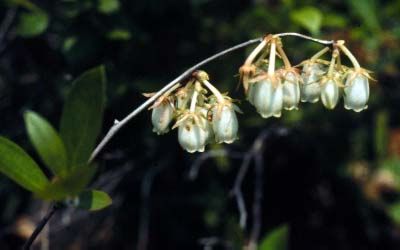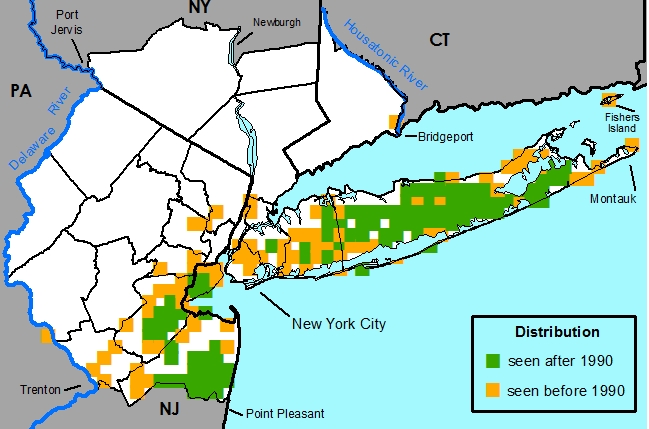Lyonia mariana (L.) D. Don - Staggerbush

Staggerbush
Photo © Peter Nelson, 1971, taken in the New Jersey Pine Barrens
Common Names
StaggerbushField Identification
Evergreen shrub with elliptic leaves, large-vase-shaped flowers, and large capsules with white ribs.Nomenclature
*Andromeda mariana L., Sp. Pl. 1: 393. 1753. *Andromeda pulchella Salisb., Prodr. Stirp. Chap. Allerton 289. 1796, nom. illeg. (Art. 52.1). *Lyonia mariana (L.) D. Don, Edinburgh New Philos. J. 17: 159. 1834. *Leucothoe mariana (L.) DC., Prodr. 7: 602. 1839. *Pieris mariana (L.) Benth. & Hook. f., Gen. Pl. 2: 588. 1876. *Neopieris mariana (L.) Britton in Britton & A. Br., Ill. Fl. N. U.S., ed 2, 2: 691. 1913. *Xolisma mariana (L.) Rehder, J. Arnold Arb. 5: 51. 1924, nom. illeg. (Art. 52.1). TYPE: United States. Virginia: P. Kalm s.n. (Lectotype: LINN 563.5 [IDC 177, f. 316, c. 1, r. 2]), selected by (Judd, 1981), see also(Reveal et al., 1987).*Andromeda grandiflora Meerb., Pl. Select. Icon. Pict., p. [8], t. 25 (ill. not seen). 1789. TYPE. United States. North Carolina: J. Fraser s.n. (Lectotype: L), selected by (Judd, 1981).
*Andromeda mariana var. ovata Veillard in Duhamel, Traité Arbr. Arbust. 1: 177. 1803. TYPE: Type not cited.
*Andromeda mariana var. oblonga Veillard in Duhamel, Traité Arbr. Arbust. 1: 177. 1803. TYPE: Type not cited.
*Andromeda mariana var. latifolia Pers., Syn. Pl. 1: 481. 1805. TYPE: Type not cited.
*Andromeda mariana var. ovalis Sims, Bot. Mag. 38: t. 1579. 1813. TYPE: Type not designated, several elements.
*Andromeda mariana var. angustifolia Pursh, Fl. Amer. Sept. 1: 294. 1814. *Leucothoe mariana var. angustifolia (Pursh) DC., Prodr. 7(2): 602. 1839. TYPE: Type not designated, several elements. [leaves narrowly lanceolate]
*Xolisma mariana f. vestita Rehder, J. Arnold Arb. 5: 51. 1924, nom. illeg. (Art. 52.1). *Lyonia mariana f. vestita (Rehder) Parks, First Sci. Field Meet. Palmetto State Park, Texas 9, 1936. TYPE: United States. Texas: Hardin Co., Silsbee, 25 Apr 1916, Palmer 9561 (Holotype: A! #00015119).
Description
HABIT perennial, evergreen, phanerophyte, shrubs, autotrophic, monoclinous, with adventitious roots or with fibrous roots, 1-2 m tall, not modified or with rhizomes.STEMS erect or ascending, round, not winged, "regular". Prickles absent. Bark fibrous, exfoliating, light gray. Branches erect or ascending, light gray, round, not winged, 2.3-3.2 mm in diam. Twigs light orange-yellow or orange-yellow, round or slightly ridged, 1-1.7 mm in diam., smooth (sulcate), glabrous, without glands. Pith present, light yellow, round, continuous, nodal diaphragm absent. Thorns absent. Aerial roots absent. Sap translucent. Resin absent.
LEAVES alternate, 1 per node, spaced ± evenly along stem, divergent from stem, simple. Stipules absent. Leaves petiolate, petiole "typical", 0.2-0.6 cm long, hairs short and unbranched, spreading, multicellular, uniseriate, moderately dense, throughout, not glabrescent, without glands. Leaf: abaxial surface light greenish yellow, adaxial surface yellowish green, blades narrowly elliptic or elliptic or ovate, plane, symmetric, 3.2-8.7 cm long, 1.2-4.5 cm wide, coriaceous, base cuneate (to rounded), margin entire, apex acute or obtuse, abaxial surface glabrous or hairs short and unbranched, spreading, multicellular, uniseriate, white, sparse, along midveins, not glabrescent, glands present, glands sessile, dark reddish orange, adaxial surface glabrous or hairs short and unbranched, spreading, multicellular, uniseriate, white, sparse, along midveins, not glabrescent, glands present, glands sessile, dark reddish orange. Brochidodromous venation, veins 3-5. Leaf lobes absent. Spines absent. Tendrils absent.
INFLORESCENCES monomorphic, regular or, if dimorphic, female inflorescence simple, fascicle, axillary. Peduncle absent. Rachis absent, with bracts. Bracts sessile, blades: abaxial surface light greenish yellow, adaxial surface greenish yellow, elliptic or obovate, plane, 2-2.2 mm long, 1-1.6 mm wide, base cuneate, margin ciliate, apex acute, abaxial surface glabrous, without glands, adaxial surface glabrous, without glands. Pedicel 7-13 mm long, glabrous, glands present or without glands, glands sessile, dark reddish orange. Bracteoles 2, sessile, at base of pedicel, not connate, bracteoles: abaxial surface light orange-yellow, bracteole: adaxial surface light orange-yellow, elliptic or circular, curved, 0.6-1.2 mm long, 0.6-0.9 mm wide, base obtuse, margin entire or ciliate, apex obtuse or acute. Cupules absent.
FLOWERS serotinous, formed on short shoots, monomorphic, with sepals and petals readily distinguishable from one another, bisexual, flowers white or light red, 5-merous, 9.5-11.5 mm long, 6.8-9.5 mm wide, 3-6 flowers per inflorescence, perianth of two whorls. Calyx present, actinomorphic, campanulate, of free sepals, persistent, abaxial and adaxial surfaces the same color, light greenish yellow or light yellowish green, 5.4-7.2 mm long, 8-9.5 mm wide. Sepals or sepal lobes 5, ovate, 4.7-6 mm long, 1.4-3.2 mm wide, base truncate, margin entire, apex acuminate, abaxial surface glabrous, glands present, glands sessile, dark reddish orange, adaxial surface glabrous, without glands. Epicalyx absent. Corolla present, actinomorphic, tubular, of fused petals, deciduous, abaxial and adaxial surfaces the same color, white or light red, 9.5-11.5 mm long, 6.2-7.3 mm wide, corolla limb 2-2.5 mm long, 6.2-7.3 mm wide. Petals or petal lobes 5, "normal", deltate or shallowly deltate or shallowly triangular, 2-2.5 mm long, 2-3 mm wide, base truncate, margin entire, apex acute or obtuse, abaxial surface glabrous, glands present, glands sessile, dark reddish orange, adaxial surface glabrous, without glands. Gynoecium syncarpous. Carpels 5. Stigmas 1, truncate. Styles not persistent, 1, 4.8-6.2 mm long. Ovary superior, nectiferous disk present. Locules 5. Placentation axile. Androecium obdiplostemonous. Stamens 10, 7-10 mm long (4-7). Anthers elongate, opening by pores in terminal tubes, opening 1/4 of entire anther, bithecal, light yellowish orange, papillose, spurred (2 well developed spurs on filaments below anther). Filaments free, S-curved, white or light red, hairs short and unbranched, erect, unicellular, uniseriate. Staminodes absent.
FRUITS loculicidal capsules, dark orange-red or dark gray, pyriform (ovoid), 4.3-4.9 mm long, 4-4.5 mm wide, glabrous, without glands.
SEEDS many, dark reddish violet or orange-yellow, oblong, 1-1.1 mm long, 0.2-0.3 mm wide, wingless, not tailed, lineolate or lineate.
Habitat
(Wherry, 1920)Dry sandy areas (open fields, barrens, swales, pine woods, oak woods, sand dunes) and occasionally wet areas (bogs, pine barren swamps, and moors) in dry upland peat and occasionally moist peat.
Rarity Status
Heritage global rank -- G5Connecticut -- Special Concern
New Jersey -- Not listed
New York -- Not listed
Species Biology
Flowering(April [week 2]) May [week 3] - July [week 3] and September [week 3] - November [week 1].
Pollination
Unknown.
Fruiting
June [week 4] - December [week 4], old fruit persisting until June [week 2].
Dispersal
Unknown.
Germination
Unknown.